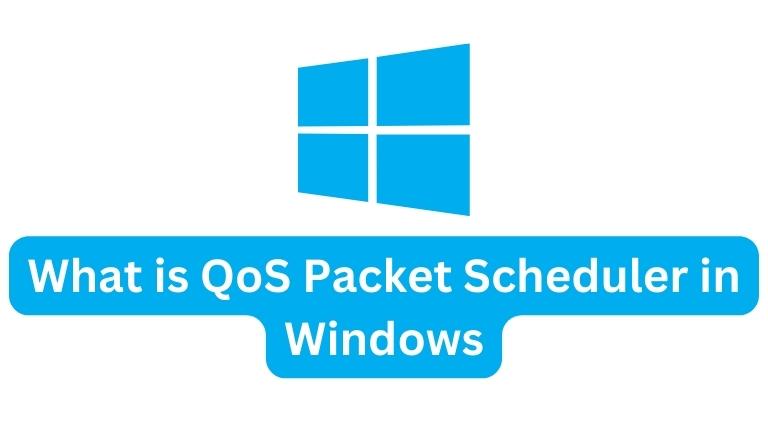If you’re a Windows user, you’ve likely encountered the term “QoS Packet Scheduler” at some point. But what does it mean exactly? What is its purpose and how does it work?
This article aims to answer these questions and provide a complete guide to the QoS Packet Scheduler in Windows.
What is QoS Packet Scheduler?
QoS Packet Scheduler is a feature in the Windows operating system that is designed to improve network quality of service (QoS).
It works by allocating and prioritizing network bandwidth for different applications and services based on their priority level.
This mechanism manages network traffic by giving preference to certain types of data over others. Essentially, it ensures that high-priority applications and services receive the necessary network resources to function properly, while lower-priority data is deprioritized or throttled to prevent congestion and network lag.
Why do we need QoS Packet Scheduler?
With the increasing number of devices and applications connected to the internet, managing network traffic has become crucial.
QoS Packet Scheduler enables us to allocate network bandwidth to various applications and services based on their priority level, ensuring that essential applications and services receive the necessary bandwidth to function correctly.
This feature is particularly useful in environments where multiple devices and applications are competing for bandwidth.
How does QoS Packet Scheduler work?
The QoS Packet Scheduler functions by assigning priority levels to data packets that are transmitted over the network.
These priority levels are labeled 0 to 7, with 0 being the lowest priority and 7 being the highest.
QoS Packet Scheduler uses these priority tags to give preference to network traffic and distribute bandwidth accordingly.
How to enable/disable QoS Packet Scheduler in Windows?
To disable QoS Packet Scheduler in Windows, you can follow these steps:
- Press the “Windows + R” keys to open the “Run” dialog box.
- Type “gpedit.msc” and press “Enter”.
- Navigate to “Computer Configuration” -> “Administrative Templates” -> “Network” -> “QoS Packet Scheduler”.
- Double-click “Limit reservable bandwidth”.
- Select “Enabled”.
- Set the bandwidth limit to 0%.
- Click “OK” to save changes.
These steps will disable QoS Packet Scheduler and prevent it from prioritizing network traffic and allocating bandwidth based on priority levels. However, it is worth noting that disabling QoS Packet Scheduler may negatively impact network performance and cause certain applications to function poorly.
QoS Packet Scheduler vs. Network Quality of Service
QoS Packet Scheduler is just one component of the broader Network Quality of Service (QoS) technologies used in Windows operating systems to manage network traffic.
QoS covers a range of techniques and methods for managing and prioritizing network traffic, while QoS Packet Scheduler specifically handles the prioritization and allocation of network bandwidth for various applications and services.
QoS Packet Scheduler and Online Gaming
Having a stable and fast internet connection is crucial for online gaming. QoS Packet Scheduler can help by prioritizing online gaming traffic over other types of network traffic, guaranteeing that the game receives the required bandwidth to function properly.
This prioritization results in reduced lag and latency, enhancing the overall gaming experience.
Common issues with QoS Packet Scheduler
QoS Packet Schedulers can face common issues such as slow network performance, network congestion, and network latency.
Troubleshooting QoS Packet Scheduler issues
If you’re experiencing problems with QoS Packet Scheduler, here are some troubleshooting steps you can take:
- Check if QoS Packet Scheduler is enabled on your computer. If it’s not, enable it.
- Verify that your network configuration settings are correct and that QoS Packet Scheduler is properly configured.
- Check if any other applications or services are using an excessive amount of bandwidth. You may need to limit their bandwidth usage.
- Make sure your network drivers are up-to-date. Outdated drivers can cause problems with QoS Packet Scheduler.
QoS Packet Scheduler and VPN
Using a VPN encrypts and routes your network traffic through a remote server. By utilizing QoS Packet Scheduler, you can prioritize VPN traffic over other network traffic, ensuring your VPN connection remains stable and fast.
This can be particularly helpful when using the VPN for sensitive activities, such as online banking or accessing confidential work files.
QoS Packet Scheduler and VoIP
Voice over IP (VoIP) requires a stable and fast internet connection to ensure clear and uninterrupted calls.
QoS Packet Scheduler is a useful tool that can be used to prioritize VoIP traffic over other types of network traffic, helping to ensure that your VoIP calls are not affected by network congestion or latency.
QoS Packet Scheduler and Multimedia streaming
Streaming multimedia such as videos and music requires a fast and stable internet connection.
QoS Packet Scheduler is a useful tool to prioritize multimedia streaming traffic over other types of network traffic.
It ensures that your multimedia content is delivered smoothly and without buffering or interruptions.
QoS Packet Scheduler and File Transfer
When transferring large files over the network, it is essential to have a fast and stable internet connection.
QoS Packet Scheduler can be used to prioritize file transfer traffic over other types of network traffic, ensuring that the file transfer is completed quickly and without any interruptions.
This can be especially useful when transferring large files over a shared network where other applications and services may also be using the network.
By prioritizing file transfer traffic, QoS Packet Scheduler can help ensure that the file transfer is completed efficiently without affecting the performance of other network applications and services.
QoS Packet Scheduler and Background Intelligent Transfer Service (BITS)
Background Intelligent Transfer Service (BITS) is a Microsoft service that allows file transfers to continue in the background while the user continues to use their computer.
QoS Packet Scheduler can be used to prioritize BITS traffic over other types of network traffic, ensuring that file transfers are complete quickly without interrupting the user’s work.
QoS Packet Scheduler and HTTP traffic
HTTP traffic refers to internet activities such as web browsing and email. By using QoS Packet Scheduler, you can prioritize HTTP traffic over other types of network traffic, ensuring that your web browsing and email activity remain fast and responsive.
Conclusion
In conclusion, QoS Packet Scheduler plays an important role in the Windows operating system by managing and prioritizing network traffic.
It allocates bandwidth based on priority levels, guaranteeing that essential applications and services have the necessary bandwidth to function correctly.
Whether you are gaming online, using VoIP, or streaming multimedia content, QoS Packet Scheduler can ensure a stable and fast internet connection for your needs.









